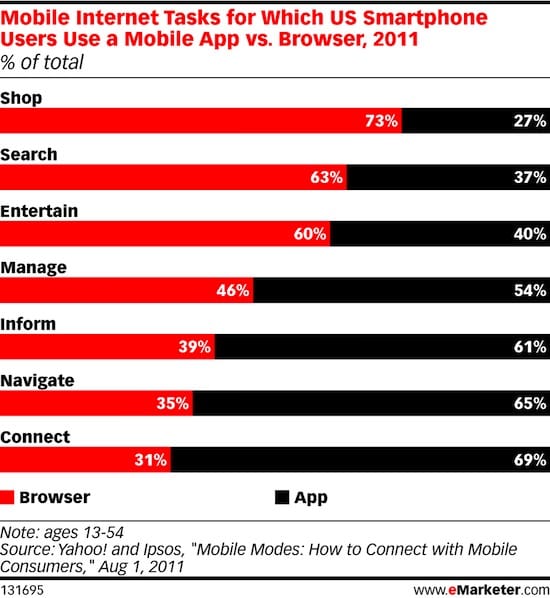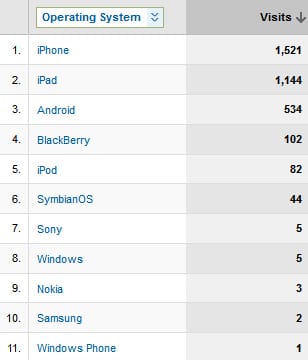Using Google Analytics to review changes in mobile site usage by prospects and customers
As mobile device usage rapidly increases amongst buyers and influencers accessing content related to your products or services, it may be the perfect reason to start thinking about developing a mobile app or making your website mobile friendly as part of your sales and marketing toolbox.
A client of ours saw mobile traffic to their website increase by 284% in 2011 compared to 2010. Our client manufacturer of stainless steel reinforcement rods (not the most glamorous of products) saw the rate at which the site is accessed from a mobile device increase dramatically.

Mobile visitor growth for B2B product manufacturer
After conducting many audits on websites, the biggest growth I have reported every single time for every single client is the growth in mobile traffic. It’s time B2B companies took mobile more seriously. How much has mobile traffic to your website increased ?
Think of all those people who have viewed your site on a mobile device. What do you think their experience was like? A pleasant one or was the site so poorly presented on a mobile device that they never came back again to read more content? Or did they find your competitors website where they managed to get the information they required. It’s all about them mobile experience. We’ll come onto that later.
Before we review the 5 questions, let’s clear one thing up…
A mobile device is not just classed as a mobile phone. Mobile devices also include tablet devices such as iPads, the Samsung Galaxy Tablet or the Blackberry Playbook. It is predicted that sales of tablet devices is about to explode and will overtake sales of desktop PCs by 2015.
Back in November 2011, we launched a new site for a client who manufactures timber products and the below graph shows the rate at which mobile traffic had increased in just 5 months.

Mobile traffic growth in 5 months
So, if you are required to put together a business case pushing for the need of a company app then you may want to start looking into some of the data in Google Analytics to help you back up your theories and plans.
Here are 5 things to consider before developing an mobile marketing strategy (apart from the obvious ‘what problem are you trying to solve?’) which will help you focus on the key bits of information to gather, think about and plan before launching a mobile marketing plan.
1. How has mobile traffic to your website changed?
As we have already seen through the data presented earlier, at what rate is mobile traffic growing to your website? Is there enough growth to warrant a mobile marketing strategy? Is the quantity of visits increasing and does it look more than likely that it will continue to increase at such a rate for the next 3-5 years. Many marketers survey their own customers and ask “Do you use a smartphone for work?” and most may say “Yes”, BUT they may not necessarily want to view your site on a mobile or have the need to when they can use their desktop in the office, the king thing to consider here is the type of information the B2B buyer requires on a mobile device. It could be blog content, product updates or event information.
Mobile traffic to the Pauley Creative website increased by 551% in 2011 compared to 2010.

- Increase in visits from mobile devices
What is interesting is that no other metrics had changed that much in the 12 months such as pages viewed per visit and time on site other than the number of visits from a mobile device. This could be largely due to the fact that majority of our traffic is acquired through social media channels where the blog is the main destination for our audience and only one post will be consumed.
2. Which sources are my mobile visitors coming from?
There may be a small percentage of visitors coming to your website from a mobile device to just have a general browse (like the businesswoman who is just browsing your website before your 2pm meeting) but there may be a large percentage who are looking for information much more specific or technical related. In Google Analytics you can segment your mobile traffic and have a look at where they are coming from. Are they coming from Google? What did they search for and what page did they land on? Did they get the information they required? You may find that browsing times on a mobile device may be short lived so don’t worry about bounce rate too much if your website is content heavy.

Which sources are mobile visits coming from?
Sources of traffic from mobile devices - Google wins again!
If 7.70% of visitors are coming from a referring website then was that referring website mobile friendly? If it was, then it could be your website which proves to be a stumbling block in your visitors’ journey. Remember, if your company is on Twitter then most of your website visitors may be coming from social sources and from a mobile device. You may also be using QR codes to drive traffic through to your website. Again, QR codes are for mobile devices so how does your website look once they’ve scanned the code?
Ok so majority of traffic will be from social media savvy B2B professionals but what about those who are not familiar with the brand but have come to the site through a Google search on a mobile device just looking for information on digital marketing?

- Organic traffic from mobile devices
A 420% increase in traffic to the Pauley Creative website from people who have searched using a non-brand related search phrase in Google through a mobile device.
3. What are mobile visitors looking for in particular?
So if the majority of your mobile traffic is coming from search engines, as the above data shows, then what are they searching for? Again, you can use Google Analytics to understand what information people need from your site whilst on a mobile device by using advanced segments.

Types of search terms used by mobile visitors
As you can see from the above example of non-branded search terms, there are a mix of information based search terms and location based search terms. The location based search terms could be on-site engineers, influencers, buyers who require spares or support offices and are looking to buy immediately, therefore need to know where the nearest stockist is located. Through the use of an app which uses Google Maps it is possible to then also provide driving directions to the local stockist.
What should your mobile marketing strategy be focusing on? Delivering the right content in a mobile friendly way to reduce customer service calls or making it easier to find stockists of your product within a given location to increase demand form distributors?
4. Native app, Hybrid App or Web based app?
Before you go delving into the world of mobile marketing you will need to know the difference between a native app, hybrid app and a web app. A native app is an app you download and install onto your device and is coded with specific programming language and are fast, reliable and powerful. No phone signal is required for a native app and can be used offline. A hybrid app relies on a framework and offer cross platform compatibility so you can use the phone’s hardware such as contacts or GPS for maps making this option ideal if you are wanting to integrate a map. A web app runs like a website but but is tailored to match every web enabled phone, like Wikipedia mobile page and requires a good phone signal (3G or Wi-Fi) to work at all times.
Website design is evolving every day and if you are not already familiar with ‘Responsive Website Design’ then I suggest you research into it. Responsive website design is where the website actively responds to the device and browser resolution the website is being viewed on. It automatically detects the size of the window and automatically re-sizes and re-formats the website to be viewed in that window.
The tricky part is that there is no best choice but very much depends on what your requirements are and what you want the app or website to do.

What do mobile users do?
5. If you are developing an app what device will you develop for?
iPhones may be the largest used device amongst your audience but Android is growing rapidly too. How many of the your B2B audience use an iPhone, iPad, Android or Blackberry? Again, going back to your Analytics you can view which devices and operating systems are the most popular amongst those that come and interact with your website.

Which mobile devices tops your list?
Which device has seen the most growth over the years? iPhone or iPad? Android or Blackberry? Can you see a trend over the previous 3 years as more and more businesses move away from Blackberry as the mobile of choice to iPhone? Are Blackberry users spending less time on the site compared to Android users? Most importantly, which device converts the most visitors into enquiries?
IMPORTANT: Don’t just develop or make plans just for the iPhone if the majority of your audience are Android users. If you develop just for the iOS devices then what about all those who use Android? Have you got the budget to develop for both platforms? The below data shows that more enquiries and visitors come from an iPad device than an iPhone. Why isn’t anyone converting into an enquiry from a phone running Android?

How many visitors from mobile devices convert into enquiries?
Whilst the numbers may be small from a conversion point of view, each enquiry may have had a sales value opportunity of around £140,000. Plus you may see benefits elsewhere such as reduced number of customer service calls due to people being able to find the answers via an app or a mobile friendly website. It's depending on what your objectives were of course. Once you have this information you should ask yourself which device(s) do I want to grow and generate enquiries from?
If you have a stockist locator on your website and this is the area you want to have a mobile marketing plan for then the goal should be to identify the number of visitor who end up finding the nearest stockist and then calling them via the a mobile device. How will you measure this and will you be expecting a rise in demand and sales from distributors? What if it is to reduce the number of customer service calls so your employees can spend more time on quality calls rather than answering those simple questions which could have been answered via the website.
BONUS TIP: Remember to budget for updates, maintenance of your app and the cost of marketing your mobile plan.
Once your app or mobile website is launched… that’s not the end of the project. It has only just begun!
You will need to remember that there will be maintenance, management and updates to the platforms once in a while. There will also be refinements required as people start to leave feedback, some will be negative. If you launch an app showcasing products or case studies and you get lots of negative feedback (i.e. Don’t buy this app, it’s worthless!) what are you going to do?
Hopefully these 5 (and a bit) considerations should be enough to help you put together a B2B mobile marketing strategy. Remember to get as much data out of your Analytics software as possible, look for trends such as peak times and days, type of content consumption and search terms, loyalty, types of devices used and finally most importantly conversion rates. Can they be improved if you had a mobile marketing strategy? An app or a mobile friendly website?
Are there any other points which need to also be considered? Instead of just developing a mobile strategy for the sake of a mobile strategy think about what problem you want to solve. Do you want to reduce the amount of incoming calls into the support centre? Do you want to utilise your blog so that you can build a loyal readership who you can then nurture into customers?















